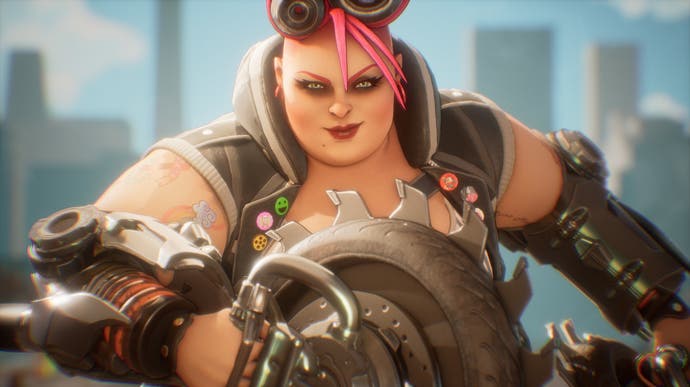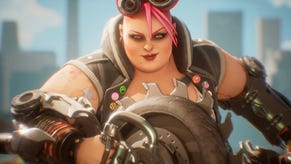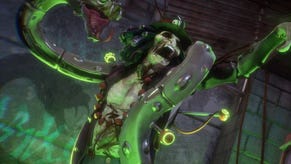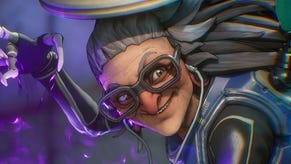Bleeding Edge review: fun fighting let down by a bare-bones launch
Sharpen up.
Bleeding Edge poses a question I hadn't considered before: what if the combat from Devil May Cry met Overwatch? A modestly-sized development team at Ninja Theory, spearheaded by DmC Devil May Cry combat designer Rahni Tucker, has worked for the past four years to come up with an answer. The result is a mixed bag. Bleeding Edge is, fundamentally, a fun experience, but it is a tad bland. And this launch on Xbox One and PC feels bare-bones, to put it lightly.
Here's the setup: two teams of four work together to knock lumps out of each other while fighting for control points or, in the second of the two available game modes, energy canisters. There are 11 characters at launch, categorised into one of three roles: damage, support or tank, and already just two days after Bleeding Edge's release that doesn't feel like enough. The diverse roster of augmented heroes (augmentation is a theme, here) is made up of a few Overwatch-alikes and a handful of really quite impressive designs, all drenched in a sort of Borderlands meets '90s sci-fi aesthetic that rekindles memories of hazy summers spent listening to Garbage. One of the characters is called Zero Cool, a nod to Jonny Lee Miller's character of the same name from that most wonderfully crap mid-90s cyber thriller, Hackers.
I find myself gravitating towards a few of the characters in particular, the ones that work a little differently to the rank and file. Maeve is a granny (you don't see many older women in video games - nice one Ninja Theory!) from Wicklow, Ireland, who is a cyber witch ranged assassin who rides a hovering bauble. The trick with Maeve is to perfectly time her traps and land killing blows, the latter of which resets her abilities. Struggle with this and Maeve's a lightweight. But if you can dip in and out of combat, snatching last hit after last hit, she's a beast.
On the support side, I enjoy playing as Kulev, who is - and stick with me here - a Voodoo-loving dead professor from Cambridge University whose soul was digitised and reborn into an automated snake that is now the arm of the mummified corpse of the aforementioned dead professor from Cambridge University. He was born in South Cheam, according to his bio. I know of no other video game characters who were born in South Cheam.
On the battlefield, Kulev is a ranged support who uses curses and boons to heal and deal damage. He's not as direct a healer as fellow support character Zero Cool, but I find him more versatile and, well, cooler.
As far as the tanks go, I have a soft spot for half motorbike girl Buttercup (her "get over here" chain ability is fun to land but hardly inspired design). Makutu, a hulking New Zealander who sacrifices an evade for the ability to switch stances between one that constantly regenerates health, or one that increases movement speed, is more interesting to play. And this is the thing about Bleeding Edge: it is only occasionally interesting. Most of the time it feels one-note.
I'm sure many will be put off by how shallow Bleeding Edge appears to feel during its initial couple of hours. This is a third-person combat game with auto-targeting and just one attack button, which you mash for a melee character's solitary combo, or hold down to auto-attack as a ranged character (you spend a lot of time pressing X in Bleeding Edge). Each character has just three specials, and you pick one super from a choice of two before heading into a match. It's pretty limited.
As a result, it feels like your success is determined mostly by your team composition. In reality this is a sort of hit or miss situation. Most of the time players will pick a nice spread of roles - a tank, two damage dealers and a healer, perhaps - but without a role queue you inevitably find yourself paired with a team who refuses to deviate from the ultra popular damage dealers - despite the in-game warning that pops up if you fail to pick a support character.
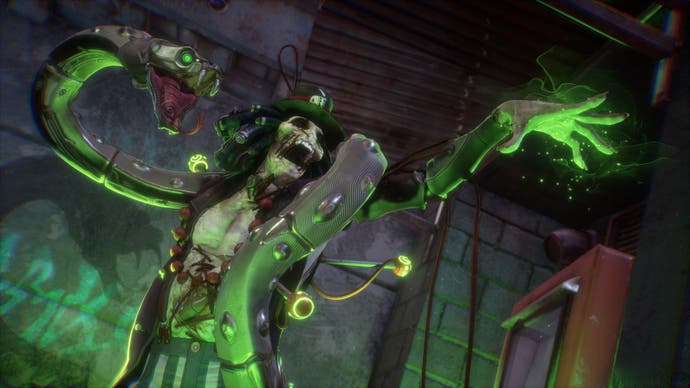
Bleeding Edge also warns that communication is key, and it's true that if you're playing with people who stick together, you have a much higher chance of winning. Winning is of course fun! But when you're in a team of players who do not stick together, Bleeding Edge can feel like pulling teeth. Voice comms are on by default, but you rarely hear anyone speak. Usefully, there's a ping system, but in my experience it's rarely used. Bleeding Edge does not suffer lone wolves gladly. If you get caught on your lonesome by more than one enemy player, you're done for. Bleeding Edge has a sort of MOBA feel in that teamfights are super important and chasing down enemies who try to escape can make all the difference. Target the healers first, then burn down the rest.
However, I've found the more you play Bleeding Edge, the more you start to notice there's a little bit more to combat than that. Team composition is incredibly important, yes, but with the power of mods you can tweak how your character works to re-jig their role slightly. Mod Kulev's area of effect special so that it does bonus damage, and you turn this support character into something of a shadow priest. Buttercup has a mod that adds an ally buff to her Oil Slick ability, which is by default an area of effect slow. I don't want to overstate the impact of mods - they can only take you so far. But they do increase the playstyle options per character, which is nice.
Spacing and smart movement is key - and it's here Bleeding Edge feels most like a MOBA. Moving as a group to interrupt, ambush or swarm the enemy is a tricky thing to achieve in Bleeding Edge, but it's doable. Don't fancy that fight? Keep at a safe distance while waiting for backup. Reckon you're in decent shape to get stuck in? Ping your team and go for it. Retreating is a big part of Bleeding Edge, too. There's a significant cooldown on your respawn, and given your team is made up of just four characters, staying alive can make all the difference. If Bleeding Edge has a skill gap, it'll be found in the quiet spaces between the action.

Bleeding Edge also has a parry, which is actually pretty tricky to time when the fights spit out virtual pyrotechnics onto your camera. Mechanically, there's a good reason why you'd want to use the parry: unlike the evade, the parry does not consume stamina. You can only dodge out of harm's way for so long, but you can parry forever - assuming you're good enough.
The problem, though, is the parry doesn't feel worth the risk of going for it. You can only parry while you're standing still - in a game that feels like it revolves around keeping on the move that feels stifling. And the effect it causes on your opponent is slight - they're pushed back a bit. The parry is a deflect, really. It's not a counter, and I wonder if it should have been, given how hard it is to do in a standard match. It would have been cool to let the characters parry while depositing energy into a collection point. Imagine how cool you'd feel deflecting an interrupt from an enemy while calmly scoring points for your team? That would be some sick 90s Neo stuff right there - and help those who are good enough to parry feel like they can do something most players can't.
Bleeding Edge's paltry parry sums up the combat, really. It's fine. It's inoffensive. It jabs rather than haymakers. Most of the supers lack spectacle, although I have to admit Nidhoggr's Ride the Lightning super, which stuns all nearby enemies with an epic guitar solo, hits the right note. Ultimately, though, the bludgeoning in Bleeding Edge is mostly monotonous.
Bleeding Edge has a more pressing problem, though. It has released in such a bare bones state that it feels like a soft launch rather than a full release. Bleeding Edge has just two game modes and already they're starting to feel old. The power cell collecting and depositing mode is quite obviously weaker than the standard control mode, and I wince whenever the game puts me in it. There are a handful of maps but they all look and feel similar. Mekko, the dolphin who pilots a fishbowl crab mech via a Japanese AI, was supposed to be in the game at launch but is now down as coming soon. There is no ranked play and no meaningful progression system. As you play you level up your profile and your character, but only with the purpose of unlocking mods and earning credits for cosmetics. Ninja Theory has promised Bleeding Edge does not and will not have microtransactions, which I find surprising, but what's in the game to unlock at launch is uninspiring. There are different board types, stickers for your board and board trails to buy with virtual credits, but I'm more interested in the character skins. Ah - there are just two per character and they're palette swaps! The emotes are fun but, again, there are only a few to unlock per character. Some characters only have one emote to unlock.
Bleeding Edge is about carefree scraps with a few pals you just met against some random chancers, not unlike a night out in Cheam, actually. Hit FIGHT and the game finds you a match with as little fuss as possible. Hopefully you're playing with people who stick together, rather than waddle off like some maddening toddler speeding towards their inevitable doom. Rinse and repeat, the hidden rating system (hopefully) working behind the scenes to huddle players of similar skill level together. If you lose - oh well, you get a completion bonus, some experience points and a handful of credits. Win and you get a few more. Do I think Game Pass and the Lockdown (both of which sound like characters in the game) will carry Bleeding Edge till the summer? The combat is just about good enough to get away with it for now, but without some meaningful updates I'll probably lose interest sooner rather than later.
